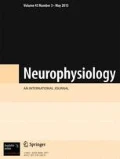Abstract
We studied correlations of the main parameters of evoked EEG potentials (EP) with individual characteristics of attention in children and teenagers. One hundred and one healthy children (dextrals) took part in the tests. Among them, 26 and 30 children were 5 to 7 and 10 to 12 years old, while the third age group included 45 teenagers (15 to 16 years old). We recorded EP and measured the time of a sensorimotor reaction in the following experimental paradigm. Its program provided automated presentation of a pair of acoustic signals, preliminary and imperative; the subject had to perform a motor reaction, pushing a button with the right thumb, with a minimum delay after the second stimulus. Visual feedback signals informed the subject about the successful or inadequate performance of the reaction (time of reaction was shorter than or exceeded a limit value). Indices characterizing the level of attention were estimated using “Find and delete ” and “Schulte’s tables” techniques. A well-manifested N2 component of the EP related to the preliminary signal was a specific feature in the group of 5- to 7-year-old children, while the contingent negative variation (CNV) preceding the motor reaction was poorly developed in this group. The best characteristics of attention in these and older (10 to 12 years old) children were typical of subjects with maximally expressed N1-P2 waves. In teenagers, the best attention was typical of subjects with the highest-amplitude P1 and P2 components, CNV, and P300 wave and with the lowest amplitude of the N1 component.
Similar content being viewed by others
REFERENCES
V. V. Gnezditskii, Evoked Potentials of the Brain in the Clinical Practice [in Russian], Taganrog Radiothechnic. Univ., Taganrog (1997).
É. M. Routman, Evoked Potentials in Psychology and Psychophysiology [in Russian], Nauka, Moscow (1979).
Ch. Shagas, Evoked Potentials in the Norm and Pathology [Russian translation], Mir, Moscow (1975).
C. Perchet and L. Garcia-Larrea, “Visuospatial attention and motor reaction in children: An electrophysiological study of the ‘Posner’ paradigm,” Psychophysiology, 37, 231–241 (2000).
R. Clarke and R. J. Barry, “EEG-defined subtypes of children with attention-deficit/hyperactivity disorder,” Clin. Neurophysiol., 112, 2098–2105 (2001).
I. N. Konareva and V. B. Pavlenko, “Individual peculiarities of cognitive evoked potentials related to resolving of a task for the time of reaction,” Tavrich. Med.-Biol. Vestnik, Nos. 1/2, 61–66 (2000).
M. V. Makarenko, V. S. Lizogoub, S. M. Khomenko, and M. G. Martynenko, “Interrelation between the successfulness of learning and neurodynamic properties of the nervous system/mental functions,” Psychophysiological and Visceral Functions in the Norm and Pathology: Proceedings of the All-Ukraine Scientific Conference Devoted to the 160th Anniversary of the Department of Human and Animal Physiology at the Kyiv Natl. Univ. [in Ukrainian], Kyiv (2002), p. 78.
V. B. Pavlenko and I. N. Konareva, “Individual personality-related characteristics of event-related EEG potentials recorded in an experimental situation requiring production of time intervals,” Neirofiziologiya/Neurophysiology, 32, No. 1, 48–55 (2000).
R. J. Barry, A. R. Clarke, and S. J. Johnstone, “A review of electrophysiology in attention-deficit/hyperactivity disorder: II. Qualitative and quantitative electroencephalography,” Clin. Neurophysiol., 114, 171–183 (2003).
R. J. Barry, S. J. Johnstone, and A. R. Clarke, “A review of electrophysiology in attention-deficit/hyperactivity disorder: II. Event-related potentials,” Clin. Neurophysiol., 114, 184–198 (2003).
S. J. Johnstone, R. J. Barry, and J. W. Anderson, “Tomographic distribution and developmental time-course of event-related potentials in two subtypes of attention hyperactivity disorder,” Int. J. Psychophysiol., No. 42, 73–94 (2001).
J. F. Lubar, “Neocortical dynamics: implications for understanding the role of neurofeedback and related techniques for the enhancement of attention,” Appl. Psychophysiol. Biofeedback, 22, No. 2, 111–126 (1997).
J. F. Lubar, “Biological feedback control, attention deficiency, and hyperactivity,” Biofeedback-3: Theory and Practice [in Russian], M. B. Shtark and A. B. Skok (eds.), Nauka, Novosibirsk (1998), pp. 142–162.
G. R. Mangun, S. A. Hillyard, and S. J. Luck, “Electrocortical substrates of visual selective attention,” Atten. Perform., 19, 219–143 (1993).
K. D. Oades, “Frontal, temporal and lateralized brain function in children with attention-deficit hyperactivity disorder: a psychophysiological and neuropsychological viewpoint on development,” Behav. Brain Res., 94, 83–95 (1998).
J. Polich, J. E. Alexander, and L. O. Bauer, “P300 topography of amplitude/latency correlations,” Brain Topogr., 9, No. 4. 275–282 (1997).
J. T. Coull, “Neural correlates of attention and arousal: insights from electrophysiology, functional neuroimaging and psychopharmacology,” Prog. Neurobiol., 55, 343–361 (1998).
R. S. Nemov, Psychology [in Russian], Vysshaya Shkola, Moscow (1994).
L. N. Kuleshova, Attention. Practice Manual for General Experimental and Applied Psychology [in Russian], Piter, Saint Petersburg (2000).
S. J. Johnstone, R. J. Barry, J. W. Anderson, and S. F. Coyle, “Age-related changes in child and adolescent event-related potential component morphology, amplitude and latency to standard and target stimuli in an auditory odd-ball task,” Int. J. Psychophysiol., 24, No. 3, 223–238 (1996).
K. Daffner, M. Mesulam, L. Scinto, et al., “Regulation of attention to novel stimuli by frontal lobes: an event-related potential study,” NeuroReport, 9, No. 5, 787–791 (1998).
R. Naatanen, Attention and Cerebral Functions [in Russian], Publishing House of the Moscow State Univ., Moscow (1998).
N. Birbaumer, T. Elbert, A. Canavan, and B. Rockstroh, “Slow potentials of the cerebral cortex and behavior,” Physiol. Rev., 70, No. 1, 1–41 (1990).
J. C. Hansen and S. A. Hillyard, “The temporal dynamics of human auditory selective attention,” Psychophysiology, 25, No. 3, 316–329 (1988).
Author information
Authors and Affiliations
Additional information
Neirofiziologiya/Neurophysiology, Vol. 36, No. 4, pp. 313–321, July–August, 2004.
Rights and permissions
About this article
Cite this article
Pavlenko, V.B., Lutsyuk, N.V. & Borisova, M.V. Correlation of the characteristics of evoked EEG potentials with individual peculiarities of attention in children. Neurophysiology 36, 276–284 (2004). https://doi.org/10.1007/s11062-005-0019-1
Received:
Issue Date:
DOI: https://doi.org/10.1007/s11062-005-0019-1


